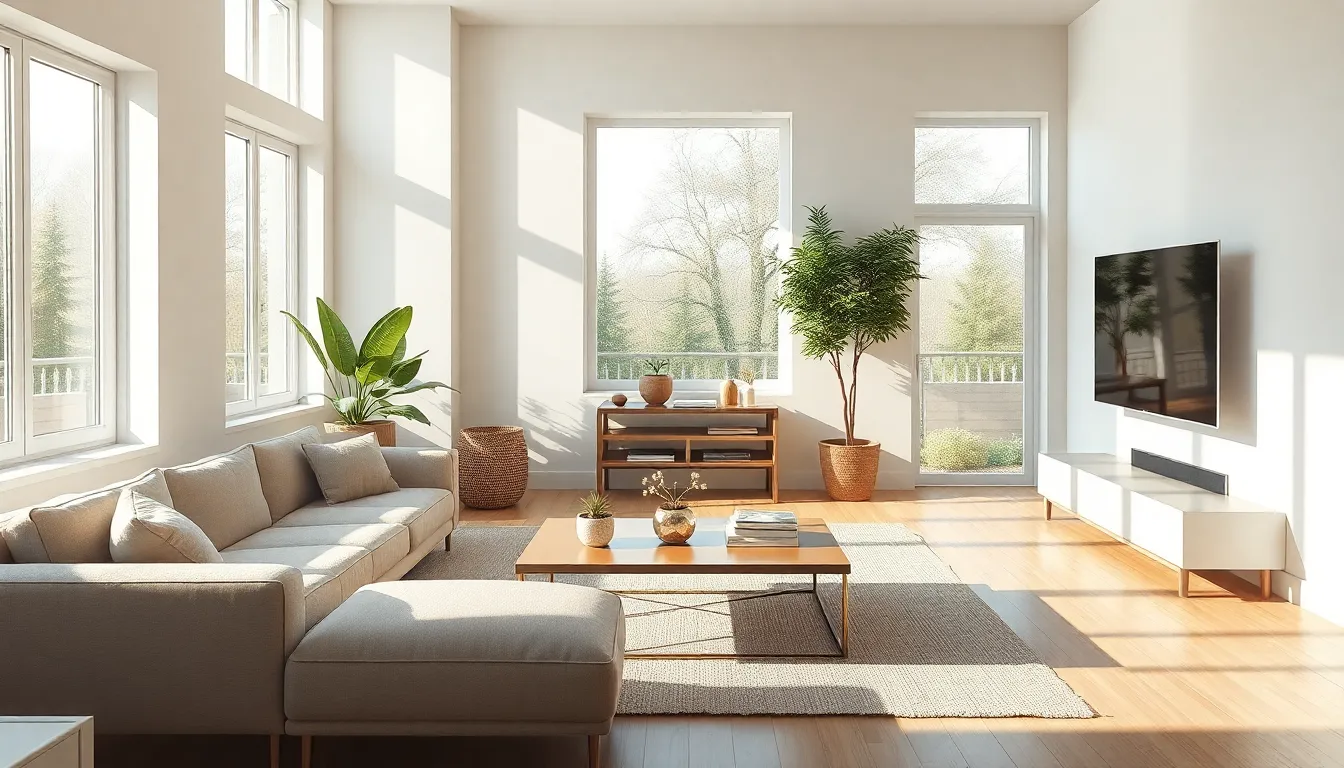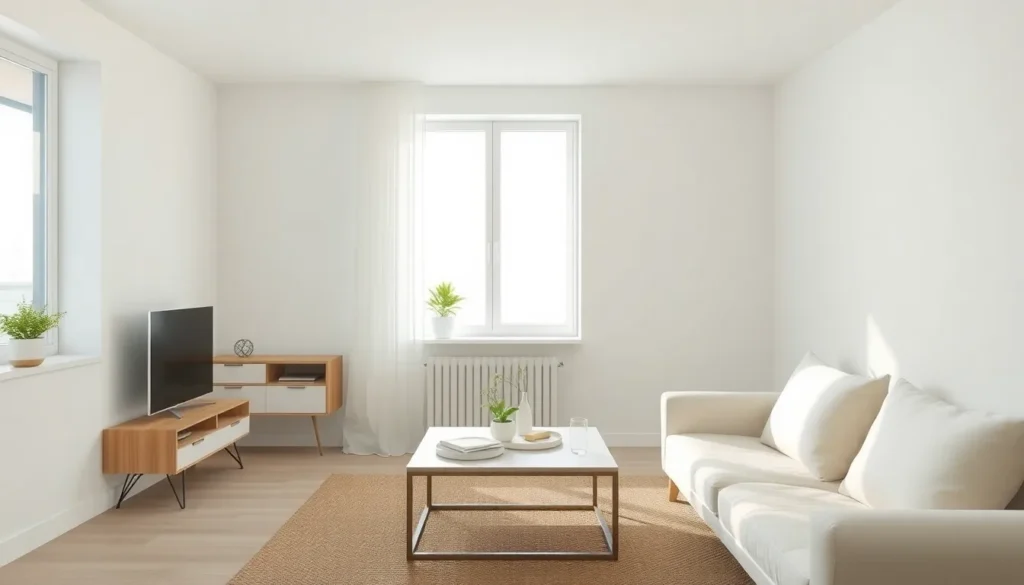Table of Contents
ToggleIn a world overflowing with clutter and chaos, minimalist interiors offer a breath of fresh air. Imagine stepping into a space where every item has a purpose and each corner invites calmness. It’s like walking into a zen garden, minus the rakes and the constant threat of stepping on a rake. Minimalism isn’t just about fewer things; it’s about creating a lifestyle that celebrates simplicity and functionality.
Understanding Minimalist Interior
Minimalist interiors emphasize simplicity and intentional design. These spaces promote tranquility and reduce visual distractions, fostering a sense of peace.
Definition of Minimalist Interior
A minimalist interior prioritizes essential elements, focusing on functionality and aesthetics. This design style often features clean lines, neutral color palettes, and a lack of unnecessary ornamentation. Functional furniture serves as design statements, showcasing form alongside purpose. Minimalist interiors encourage a thoughtful approach to space, allowing occupants to appreciate their surroundings without the chaos of excess.
Key Principles of Minimalism
Key principles of minimalism guide the creation of these serene environments. First, decluttering forms the foundation, emphasizing only the most meaningful possessions. Second, a neutral color scheme enhances light and openness, creating an inviting atmosphere. Third, functional furnishings integrate seamlessly into the design, offering utility without compromising aesthetics. Fourth, natural materials infuse warmth and character, grounding the space in authenticity. Lastly, personal touches maintain the unique identity of the interior, ensuring it reflects individual tastes while remaining cohesive.
Benefits of Minimalist Interior

Minimalist interiors provide various advantages, enhancing both aesthetics and functionality in living spaces. The benefits contribute to a harmonious environment that fosters relaxation and creativity.
Enhanced Aesthetics
Simplicity in design directly impacts the overall look of a space. Clean lines and neutral palettes create a visually appealing atmosphere. Artful arrangement of essential furnishings draws attention to key features, ensuring that each piece holds significance. Natural light plays a vital role, as fewer items allow sunlight to illuminate areas effectively. Such serenity in minimalist spaces promotes a sense of calm and order. Minimalist designs often incorporate greenery, further elevating visual interest while adhering to the minimalist philosophy. Well-chosen décor becomes a statement rather than mere embellishment.
Improved Functionality
Functionality ranks high in minimalist interiors, as every element serves a specific purpose. Practical furniture enhances usability, optimizing space without unnecessary clutter. Multi-functional pieces, such as a sofa bed, exemplify the effectiveness of minimalist design. Organized storage solutions open areas and ensure quick access to essentials. In contrast with traditional interiors, minimalism encourages mindful consumption, prioritizing quality over quantity. This thoughtful approach fosters an environment where movement remains fluid and effortless. Homes that embrace functionality often experience less stress and chaos, leading to a more productive lifestyle.
Design Elements of Minimalist Interior
Minimalist interiors emphasize simplicity through specific design elements. These elements work together to create serene and functional spaces.
Color Palette Choices
Neutral color palettes dominate minimalist design, focusing on shades like white, gray, and beige. These colors enhance natural light, promoting a bright and airy atmosphere. Subtle pops of color can occur through accessories, maintaining balance without overwhelming the senses. Soft earth tones often feature as accents, adding warmth and comfort to the environment. Whether opting for a monochromatic theme or light pastels, the key remains in creating harmony. The intention is to evoke calmness and stability through color choices.
Furniture Selection
Functional furniture defines minimalist interiors, with pieces that serve a purpose beyond aesthetics. Streamlined designs often prioritize form and utility, minimizing decorative elements. Multi-functional options are popular, allowing for flexibility in smaller spaces. Materials such as wood, metal, and glass contribute to a clean look while ensuring durability. Choosing fewer, high-quality items instead of many cheaper pieces fosters intentionality in selection. Comfort remains essential, as each furniture piece must enhance the overall experience within the space.
Tips for Creating a Minimalist Interior
Creating a minimalist interior requires intentional choices in design and function. Emphasizing simplicity enhances both aesthetics and practicality.
Decluttering Techniques
Start by evaluating your space. Recognize items that serve no purpose or add to visual clutter. Designate a specific area for essential belongings, ensuring easy access and organization. Utilize storage solutions like baskets and shelves to conceal items, promoting a clean appearance. Regularly revisit and assess belongings to maintain order and prevent accumulation. Selling or donating unused items fosters a thoughtful approach to personal possessions. Keep only what truly enhances the space and contributes to its serenity.
Space Optimization Strategies
Optimize space through smart furniture choices. Select multi-functional pieces, such as ottomans that provide storage or tables that extend. Utilize vertical space by installing shelves, drawing the eye upward and making areas feel larger. Position furniture to facilitate easy movement and fluidity. Consider integrating built-in solutions that maximize area efficiency while keeping everything streamlined. Natural light plays a crucial role; avoid heavy drapery to allow sunlight to brighten the room. Embrace open layouts that enhance connection and reduce visual barriers.
Embracing a minimalist interior transforms living spaces into serene retreats that prioritize clarity and purpose. By focusing on essential elements and functional design, individuals can cultivate environments that inspire tranquility and creativity. The principles of minimalism encourage thoughtful choices in color, furniture, and decor, allowing for a harmonious balance between aesthetics and practicality.
This intentional approach not only enhances the visual appeal of a space but also promotes a lifestyle centered around simplicity and mindfulness. Ultimately, minimalist interiors serve as a reminder that less can indeed be more, fostering a sense of peace in an increasingly chaotic world.




